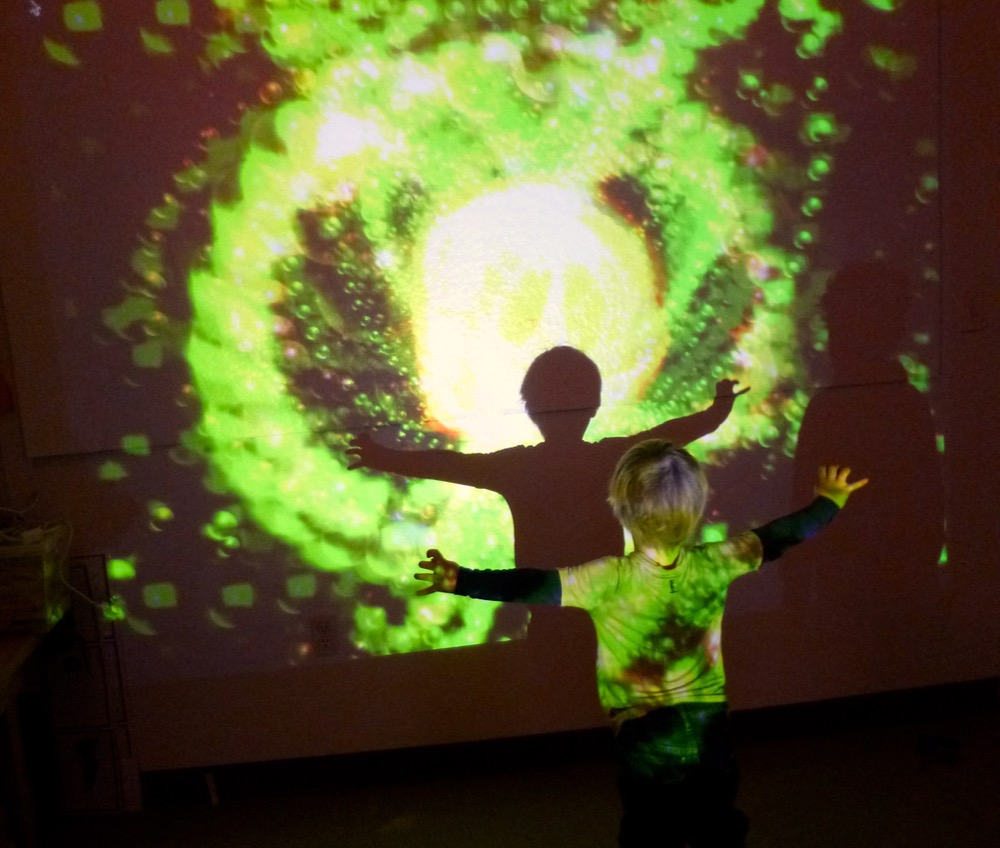 In early February, we transformed the Studio into a digitally enhanced room with projections of light, video and sound. Each day offered a different technological provocation. Our goal was to create a three-dimensional play space full of visual and auditory possibilities. This constantly transforming space was filled with an array of materials with which children could create scenes, stories, light-scapes and sonic environments.
In early February, we transformed the Studio into a digitally enhanced room with projections of light, video and sound. Each day offered a different technological provocation. Our goal was to create a three-dimensional play space full of visual and auditory possibilities. This constantly transforming space was filled with an array of materials with which children could create scenes, stories, light-scapes and sonic environments.
With the intention that every class spend some time in the Workshop to experience these new tools, some of our guiding questions were:
This workshop played with perception, light and a variety of materials. In small groups, children interacted with a digital projector connected to a web camera. The web cam was situated inside a display of found objects and fabric made to look like a small-scale, city jungle full of plastic animals. The children manipulated the objects in view, their shadows and the camera itself. This evoked a sense of wonder as they worked together in these different mediums to create lively, colorful worlds, which were projected in large scale on the wall.
We noticed that the children approached this particular workshop in several different ways:
It was fascinating to see how different groups, different ages, and even different children within the same group responded to all the possibilities within this workshop. It seemed easier for the children to interact with the light projector, and the concept of light and shadow, than they did with the web cam. We feel that a deeper exploration could be achieved if the children were more familiar with the materials and technology as separate entities before experiencing them altogether.
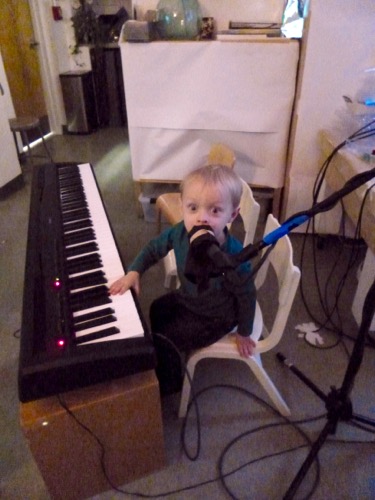 This workshop played with acoustic and amplified sound and its effects on an audio visualizer. The audio visualizer program was digitally projected against the wall so that light formations filled the room every time a sound was created. With the aid of microphones and a keyboard, in addition to the sounds they could create with their bodies, the children were able to control the intensity, volume and color of the light. In a short amount of time, they learned that they could interact with the lights in a myriad of ways. We started each session by having a small discussion, in which we gently guided the children toward making the discovery of how the lights were being turned on and off.
This workshop played with acoustic and amplified sound and its effects on an audio visualizer. The audio visualizer program was digitally projected against the wall so that light formations filled the room every time a sound was created. With the aid of microphones and a keyboard, in addition to the sounds they could create with their bodies, the children were able to control the intensity, volume and color of the light. In a short amount of time, they learned that they could interact with the lights in a myriad of ways. We started each session by having a small discussion, in which we gently guided the children toward making the discovery of how the lights were being turned on and off.
This workshop dealt largely with cause and effect. It inspired the children to experiment with their voices, to dance, and to think as they performed known songs, improvised melodies, and created rhythmic patterns with each other. While this experience felt magical and mysterious to the children at first, they learned how to control the visualizer together. One such brainstorming conversation went like this:
Cooper: "Every time I move it goes on..."
Bodin: "and every time I touch it, it goes on... It looks like lava!"
Cooper: "Yea, it goes boom-boom-boom all over the wall."
Bodin: "It's plugged into the computer."
Their explorations as they tried to make sense of the program led to a natural, musical dialogue between the children, sound, and light. Children creating a few types of sounds affected the heightened presence of light, which only spurred the children further to explore new and different ways to create sounds, and thus light!
This workshop evoked many emotions. The scale and intensity of the light was stimulating and engaging, and even fearsome. The projection of the visualizer program resembled lava, outer space, and explosions to many of the children. Figuring out how to control such an awesome visual effect seemed to be very empowering for many.
If the children seemed ready for further provocation towards the end of their time in this workshop, we ran their voices through a vocal effects processor. It changed their voices when they sang through the microphones, making it seem as if they were echoing in a canyon or talking as an alien. This was particularly useful when children seemed a little shy around the microphones.
While the visualizer program helped the children to enter into this workshop, we found that very little previous knowledge was needed for the children to engage with these concepts. The microphones were a big hit, with the keyboard being a gentler way to participate for those children who were feeling less sure of the process or the environment.
This digital drawing workshop played with perspective, light, shadow, construction and, most dramatically, color. A projector was set up to shine bright light against a blank white wall. Several feet in front of the wall, we worked with the children to build a city made of white materials - boxes, tubes, fabric, plexiglass, and Styrofoam forms - that created a shadow skyline against the wall. After the structures were completed, the children interacted with a digital projector, which was connected to a drawing tablet at the computer. The digital tablet enabled the group to have a digital effect on the surface of their buildings and on the wall behind them.

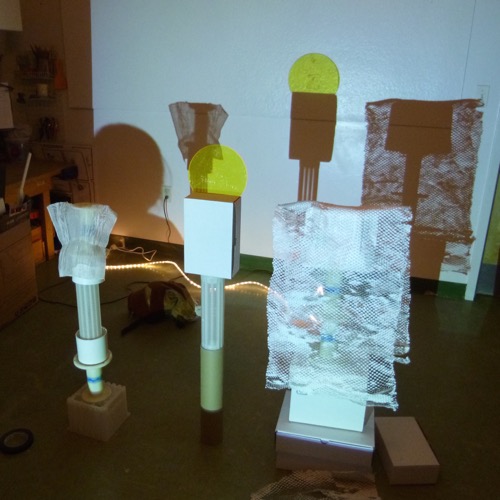
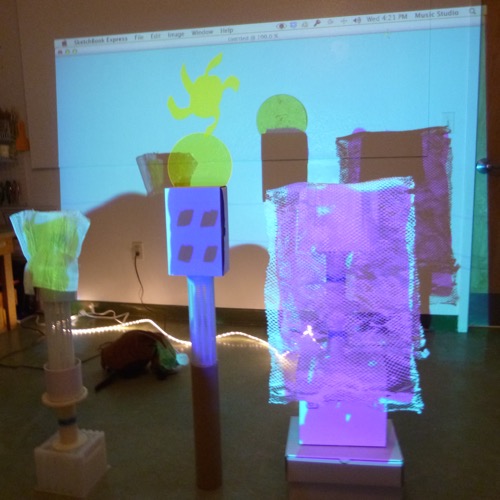
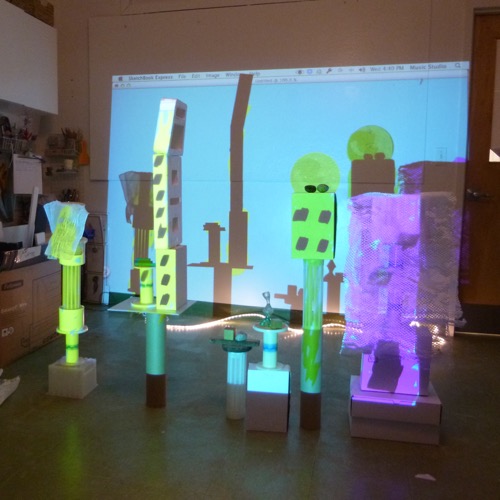
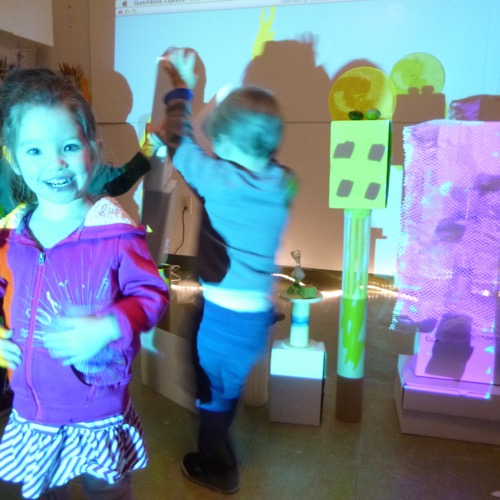
As the children worked, their cityscapes and shadow skylines changed. We took a moment to sit back and observe the white light projected against the structures, then asked the children, "What color should we paint the town?" Using their suggestions, we "painted" the town. This, in turn, inspired the children to play again with their cityscape. As they moved the materials to form new structures, the original painted cityscape remained. The children noticed this and began to play with the colorful, projected light itself. Beau taught the each child how to use the pen and tablet, while the rest of us became part of the canvas. Using this new form of technology was an amazing experience for the children. They were making their marks on the world, digitally.
The children seemed very excited by this workshop. They enjoyed the light and shadow play, the interaction of the colorful light on top of themselves and their structures, as well as learning to be the master of color with Beau at the computer. This workshop incorporated many different concepts, and if explored separately at first over a longer time period, we feel the children would be able to harness the potential of these tools as modes of expression.